Physical Address
304 North Cardinal St.
Dorchester Center, MA 02124
About 80% of adverse drug reactions are predictable and dose dependent, whereas about 20% are unpredictable and dose independent ( E-Fig. 234-1 ). These latter reactions include immediate and delayed drug allergies and hypersensitivities ( Fig. 234-1 ).
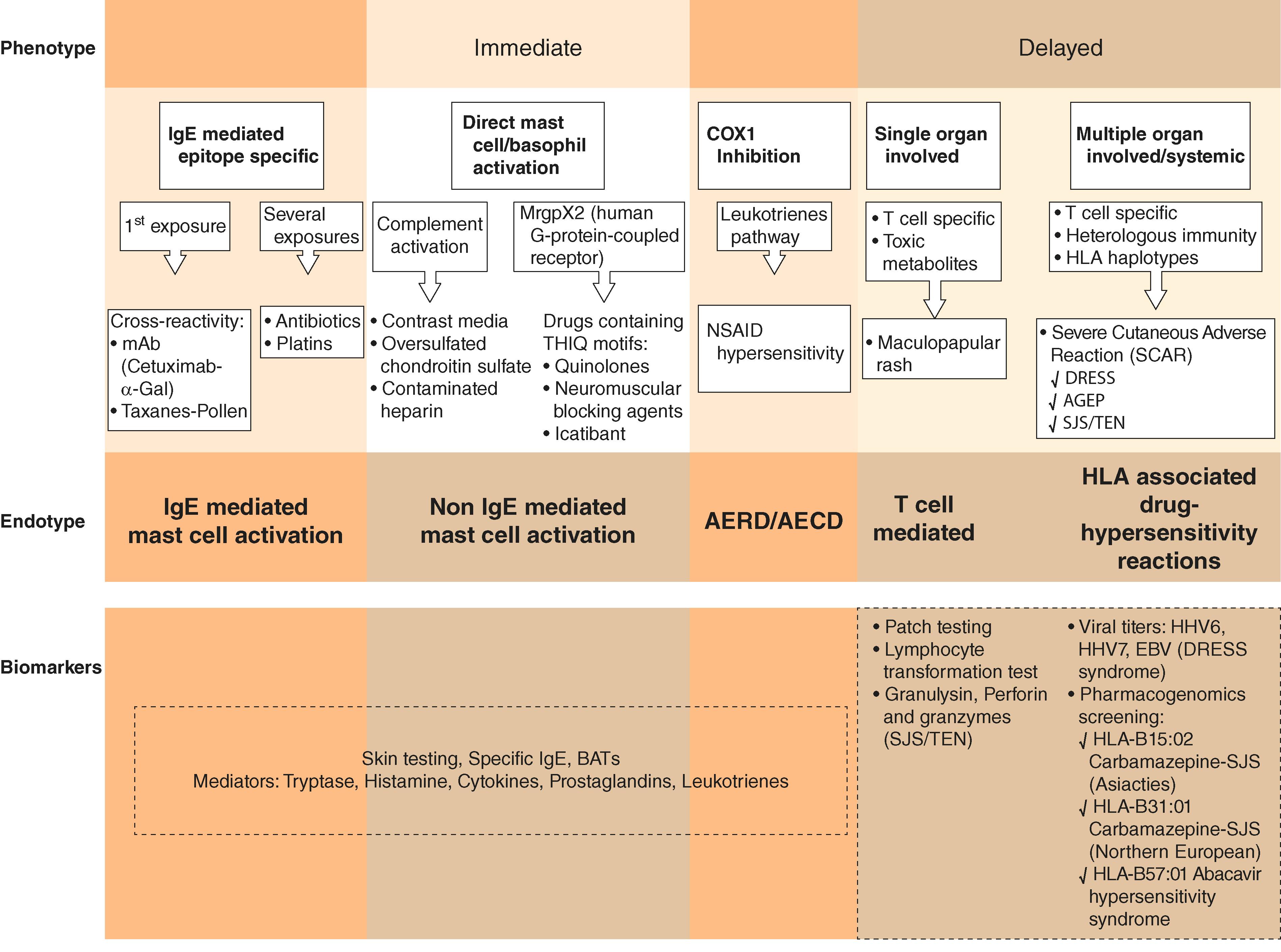
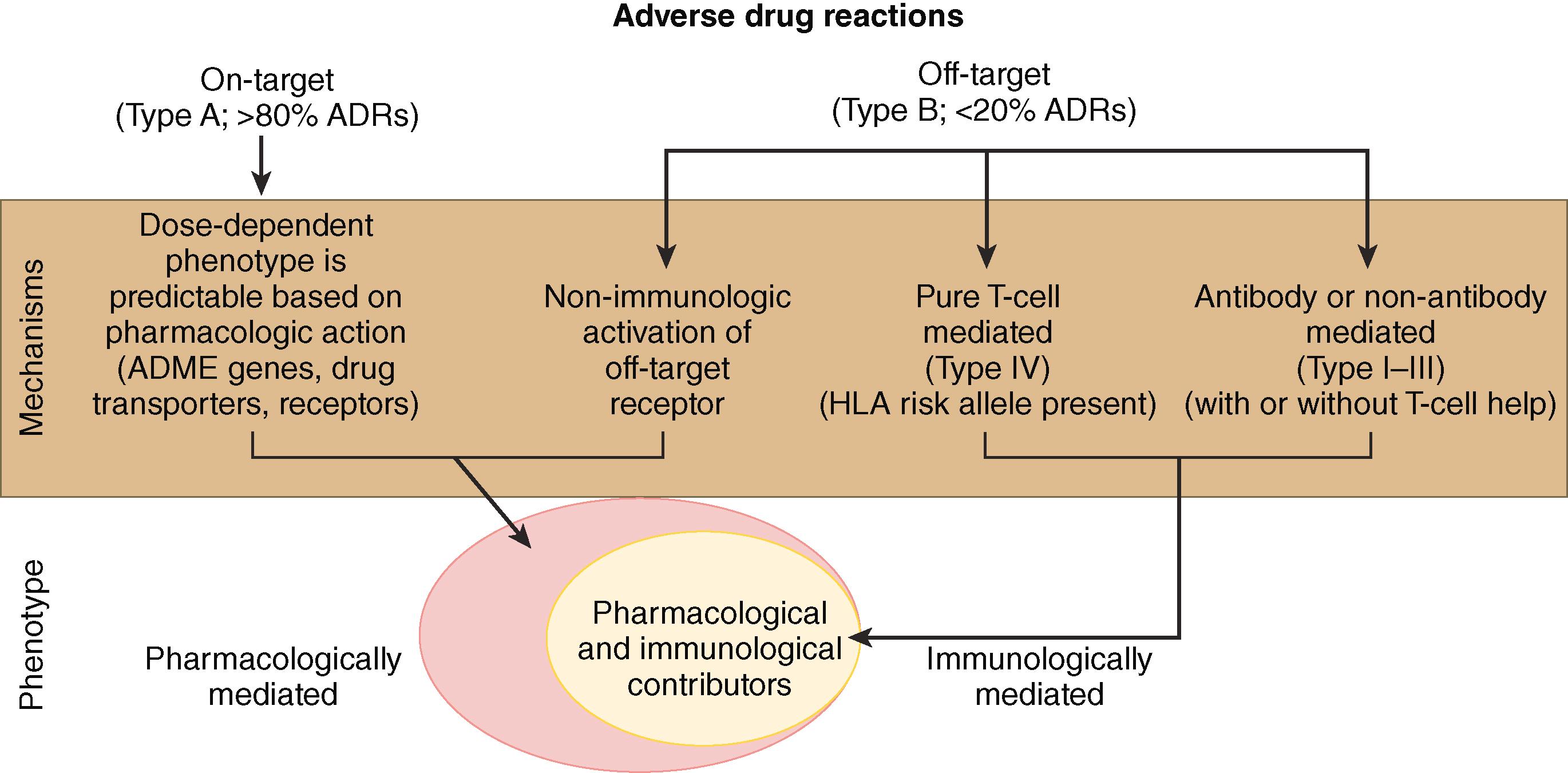
Drug allergy has a spectrum of presentations and can be fatal. Any drug can induce allergic and hypersensitivity symptoms in the appropriate context and host. The incidence and prevalence of drug allergy vary between inpatient and outpatient settings. Drug reactions that lead to visits to emergency departments occur in 4 per 1000 individuals and are more frequent in women.
The most common presentation of drug reaction is skin rash, which is observed in 2 to 4% of hospitalized patients. Antibiotics, chemotherapy drugs, monoclonal antibodies, small molecules, antihypertensive agents, contrast media, and antiepileptic agents are among the most frequently implicated ( Table 234-1 ). The incidence of drug reaction among hospitalized patients is about 6%, of which about 40% are severe drug allergy reactions and 1% result in death.
| GRADE | SEVERITY | # OF ORGAN SYSTEMS INVOLVED | ABNORMAL VITAL SIGNS |
|---|---|---|---|
| 1 | Mild | 1 | No |
| 2 | Moderate | ≥2 | No |
| 3 | Severe | ≥2 | Yes ∗ |
∗ One or more of hypotension (systolic blood pressure <90 mm Hg), hypoxia (oxygen saturation <92%), or neurologic compromise (i.e., collapse, altered level of consciousness, or seizures).
The prevalence of self-reported drug allergy is about 35%, with an average of nearly two drug allergies reported per patient. Penicillin, sulfonamides, opiates, and nonsteroidal anti-inflammatory drugs (NSAIDs) are the most frequently reported drug allergies. , For example, 20% of the general population worldwide claims to be allergic to penicillin, but further evaluation confirms the allergy in less than 1%.
The risk for sensitization to a drug depends on its chemical structure, dose, route of administration, and duration of treatment. Women are at greater risk for drug allergies than men, likely related to their immune and genetic background, cyclical exposure to endogenous and exogenous hormones, pregnancy, and exposures to cosmetics and household products. In one study for example, 70% of patients seen in an emergency department for drug-induced anaphylaxis were women. Progestogen hypersensitivity, which is a rare condition associated with allergic symptoms such as dermatitis and anaphylaxis, is observed in women who are exposed to birth control medications, in vitro fertilization, or interrupted menstrual cycles. White patients are more likely to report drug allergies, but allergies to thiazide diuretics, NSAIDs, and angiotensin-converting enzyme inhibitors are more frequent in Black patients, and angiotensin receptor blockers are more frequent in Blacks compared with Whites.
Recurrent exposure to drugs and other chemicals is associated with a higher risk of drug allergy. For example, patients who have cystic fibrosis ( Chapter 77 ) or spina bifida ( Chapter 385 ) and who undergo multiple surgical procedures are susceptible to increased sensitization to IgE and reactions to latex and antibiotics. Patients who have acquired immunodeficiency syndrome (AIDS, Chapter 355 ) also have a higher rate of drug allergy, especially dermatologic reactions to sulfa medications. The chemical structure of quaternary ammoniums that are present in cosmetics and other products is shared by general anesthetic agents, thereby potentially sensitizing individuals for perioperative anaphylaxis.
Genetics also contribute to the risk of drug allergy. Hereditary α-tryptasemia, which is an autosomal dominant inherited trait due to the duplication of the TPSAB1 tryptase gene, predisposes to anaphylaxis, including drug-induced anaphylaxis. This condition is present in 4 to 6% of the general population and is associated with blood tryptase levels greater than 9 ng/mL.
The non-IgE mast cell receptor MRGPRX2 is the target of reactions to general anesthetics, quinolones, vancomycin, and positively charged compounds. Reactions mediated by this receptor can occur upon first exposure due to direct activation of mast cells.
Multidrug hypersensitivity refers to patients who react to multiple unrelated medications. Multidrug hypersensitivity is typically associated with delayed skin symptoms, including drug reaction with eosinophilia and systemic symptoms (DRESS) and is thought to be the result of excessive T-cell stimulation with a persistent increase in activated CD4+ T cells that express PD1 and CD28.
Drug allergy can be divided into acute, antibody-mediated, immune complex-mediated, and delayed (T-cell-mediated) reactions. As illustrated by penicillin allergy ( E-Fig. 234-2 ), antibody-mediated reactions include types I, II, and III; T-cell-mediated type IV reactions are divided into IVa to IVd. Drug antigens such as insulin and haptens such as penicillin and carboplatin are bound to carrier proteins and are presented to T-cells by antigen-presenting cells during sensitization, thereby leading to the generation of cytotoxic T-cells and to the production of IgG and IgE antibodies by B-cells. The severity of immediate reactions involving two or more organs is considered anaphylaxis ( Table 234-1 ; Chapter 233 ). Additional phenotypes of immediate reactions include cytokine release reactions, mixed reactions, and complement-mediated reactions ( Fig. 234-2 ). Interleukin (IL)-6 levels at the time of a reaction are predictive of fever, chills, and oxygen desaturation in cytokine-release reactions and mixed reactions.
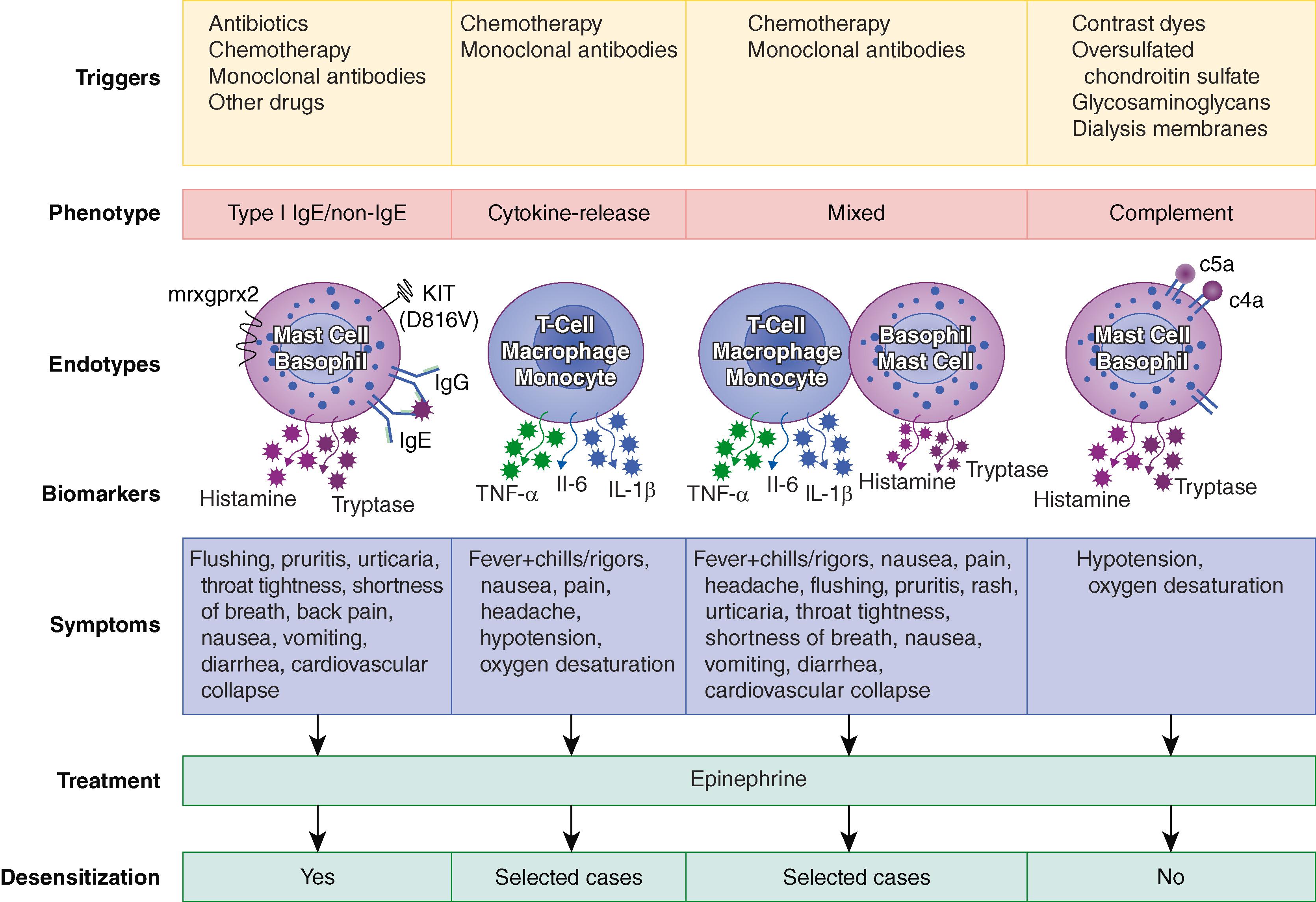
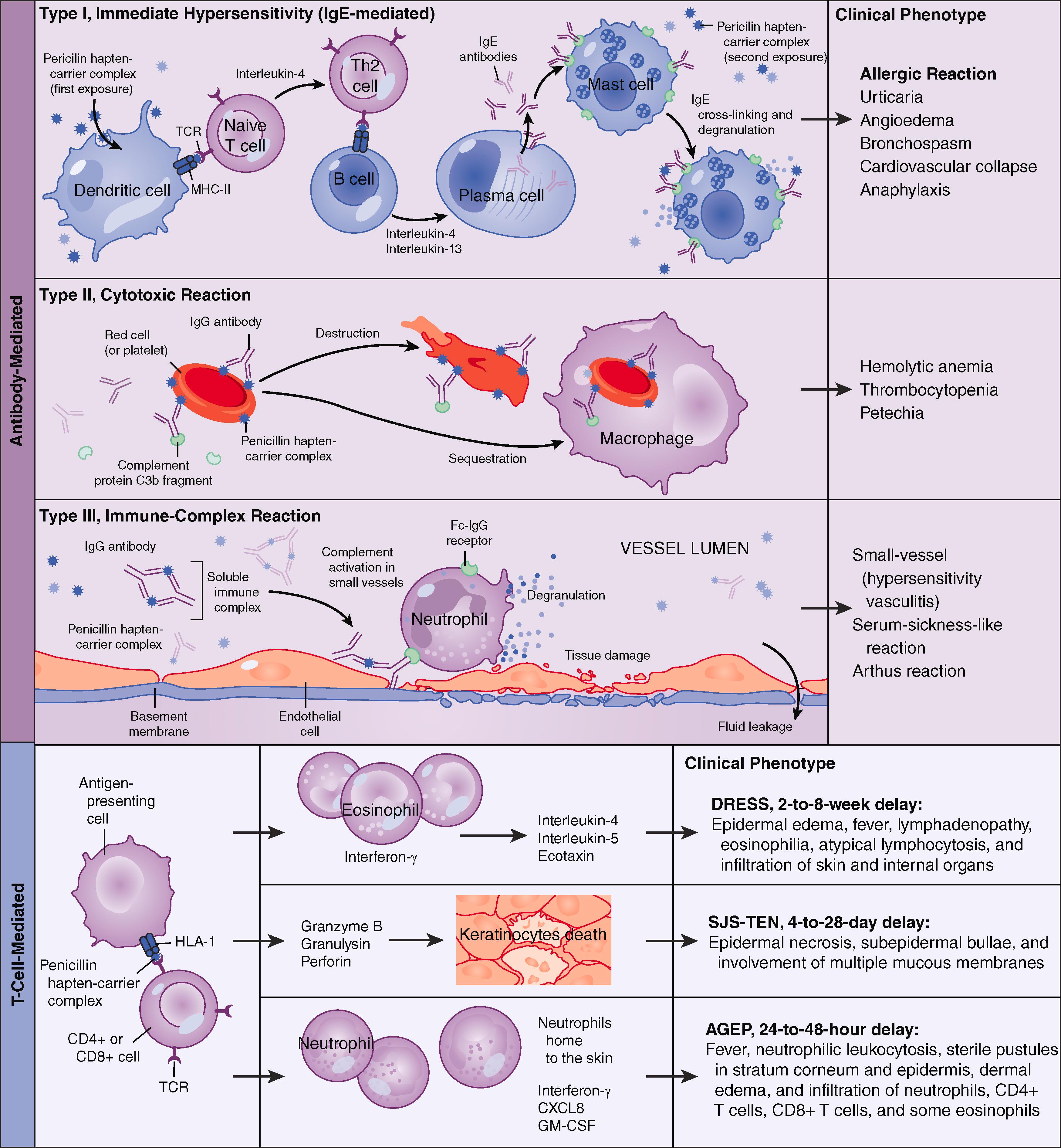
Reactions occurring 6 hours or more following drug administration can be due to immunologic and nonimmunologic off-target receptor activation and can affect a single organ or be multisystemic. Specific HLA haplotypes are associated with severe cutaneous reactions and systemic symptoms to drugs such as abacavir, carbamazepine, allopurinol, sulfonamide, and vancomycin.
The most common manifestation of a drug allergy is a rash, which ranges from mild to potentially life-threatening. The range of dermatologic conditions ( Fig. 234-3 ) include contact dermatitis, fixed drug eruptions, erythema multiforme ( Fig. 406-16 ), and angioedema ( Table 234-2 ). Patients with a drug-specific IgE (Type 1 reaction) will have symptoms that may include pruritus, erythema, angioedema, wheezing, and throat tightness.
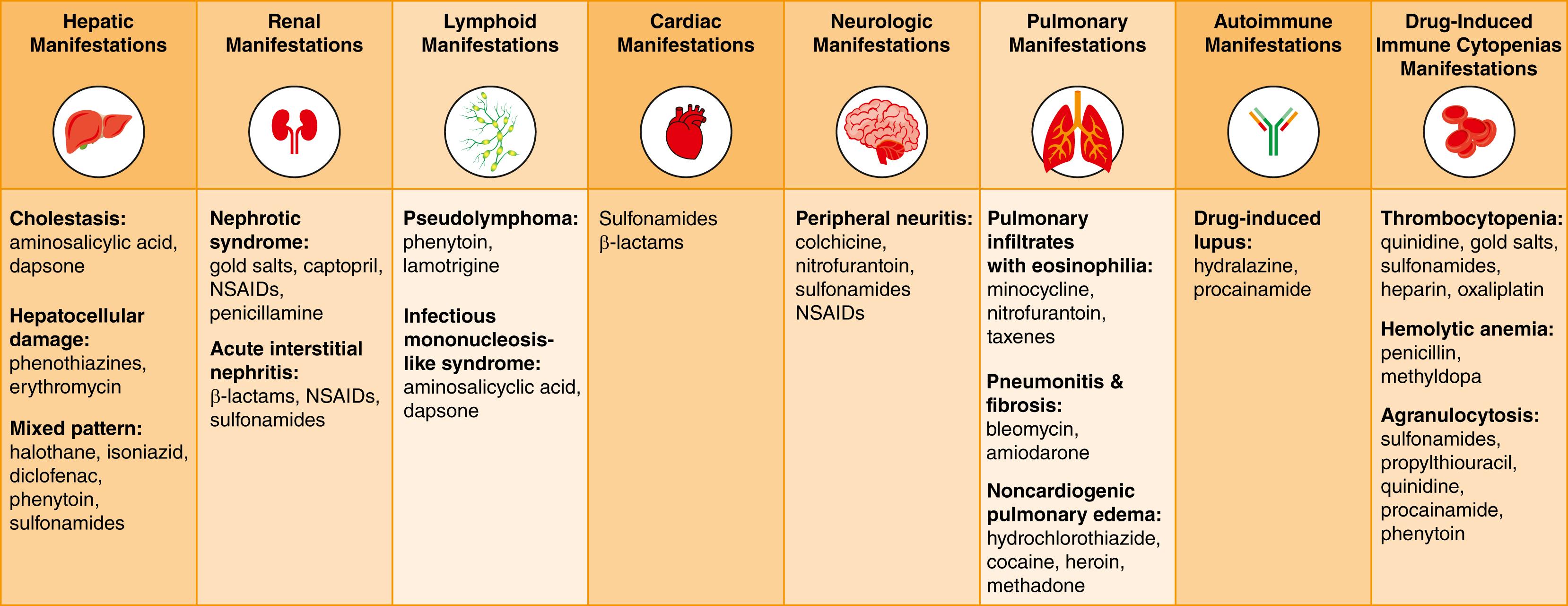
| Allopurinol Antibiotics (β-lactams, sulfas, nitrofurans) Anticonvulsants (hydantoin, phenobarbital, carbamazepine) Antihypertensive agents (angiotensin-converting enzyme inhibitors) Antipsychotic tranquilizers Antisera (antitoxins, antivirals) Antituberculosis drugs (isoniazid, rifampicin) Aspirin and nonsteroidal anti-inflammatory drugs Biologics (monoclonal antibodies such as anti–tumor necrosis factor and other recombinant DNA protein products) Chemotherapy agents (platins, doxorubicin, taxanes) Enzymes ( l -asparaginase, streptokinase, chymopapain) Muscle relaxants (rocuronium, succinylcholine) Opioids Radiocontrast media Vaccines (egg protein, gelatin) |
Several clinical entities with extreme clinical presentations must be recognized. Type I reactions ( Table 234-3 ) can result in anaphylaxis ( Chapter 233 ), which can lead to death if not diagnosed and treated promptly. Drug reaction with eosinophilia and systemic symptoms (DRESS; Fig. 407-4 ) is manifest by extensive skin rash, fever, organ involvement, and lymphocytosis/lymphadenopathy. Both Stevens-Johnson syndrome and toxic epidermal necrolysis ( Fig. 407-5 ) are characterized by extensive skin necrosis and detachment of the epidermis. Drugs can also cause a variety of reactions that are manifested in other organs, including liver reactions ( Chapter 136 ), acute interstitial nephritis ( Chapter 108 ), and pulmonary infiltrates with eosinophilia ( Chapter 82 ).
| DRUG | FREQUENCY | COMMENTS |
|---|---|---|
| Aspirin and NSAIDs | About 50% | Mechanism thought to be specific to NSAID; patients can tolerate other COX-1 inhibitors |
| β-lactam antibiotics | About 15% | Amoxicillin with clavulanic acid is common culprit |
| Fluoroquinolones | About 9% | |
| Vancomycin | Rare | Associated with “red man” syndrome and anaphylaxis |
| Radiocontrast media | 0.045% for nonionic contrast agents | Gadolinium is reported to induce anaphylactic events only one-tenth as often as radiocontrast |
| Proton-pump inhibitors | High cross-reactivity; skin testing can be used to select alternate choices | |
| Neuromuscular blocking agents | Associated with about 50% of perioperative anaphylaxis events | Mortality = 1.4%, suxamethonium, atracurium, and rocuronium are most commonly associated with anaphylaxis |
| Sugammadex | IgE mechanism | |
| Barbiturates | Direct mast cell histamine release | |
| Opioids | Can induce direct histamine release from mast cells, rarely IgE sensitization. Low potency opioids are the most common triggers; rarely seen with fentanyl | |
| Chlorhexidine | Patients can have IgE sensitization from toothpaste, mouthwash, etc. and develop anaphylaxis during operative procedures | |
| Dyes | For example, methylene blue and isosulfan blue used in cancer-mapping procedures | |
| Colloids | 0.05-0.1% | Gelatin and dextran more commonly associated with anaphylaxis compared to albumin and starch |
| Vaccines | 1/1,000,000 | COVID-19 vaccines have a higher frequency of anaphylaxis (1/100,000) |
| Local anesthetics | Rare |
Become a Clinical Tree membership for Full access and enjoy Unlimited articles
If you are a member. Log in here